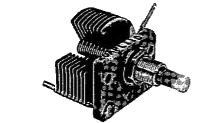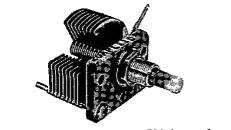Due to economic reasons , only the upper sideband of an AM wave is transmitted , but at the receiving station , there is a facility for generating the carrier . Show that if a device is available which can multiply two signals , then it is possible to recover the modulating signal at the receiver station .
Let ωc be the angular frequency of carrier waves & ωm be the angular frequency of signal waves .
Let the signal received at the receiving station be e=E1⋅cos(ωc+ωm)t
Let the instantaneous voltage of carrier wave ec=E0cosωct is available at receiving station .
Multiplying these two signals , we get
e×ec=E1Eccosωct.cos(ωc+ωm)t
E=E1Ec2⋅2.cosωct.cos(ωc+ωm)t (Lete×ec=E)
=E1Ec2[cos(ωc+ωc+ωm)t+cos(ωc+ωm−ωc)t]
∵2[cosAcosB=cos(A+B)+cos(A−B)]
E1Ec2=[cos(2ωc+ωm)t+cosωmt]
Now , at the receiving end as the signal passes through filter , it will pass the high frequency (2ωc+ωm) but obstract the frequency ωm . so we can record the modulating signal E1Ec2cosωmt which is a signal of angular frequency ωm.
Topper's Solved these Questions
- COMMUNICATION SYSTEMBOOK - VIKRAM PUBLICATION ( ANDHRA PUBLICATION)CHAPTER - COMMUNICATION SYSTEMEXERCISE - SHORT ANSWER QUESTIONS
9 Videos
- ATOMSBOOK - VIKRAM PUBLICATION ( ANDHRA PUBLICATION)CHAPTER - ATOMSEXERCISE - ADDITIONAL EXERCISES
24 Videos
- CURRENT ELECTRICITY BOOK - VIKRAM PUBLICATION ( ANDHRA PUBLICATION)CHAPTER - CURRENT ELECTRICITY EXERCISE - ADDITIONAL EXERCISES
22 Videos
Similar Questions
Due to economic reasons, only the upper side band of an AM wave is transmitted, but at the receiving station, there is a facility for generating the carrier. Show that if device is available which can multiply
two signals, then it is possible to recover the modulating signal at the receiver station.
View SolutionBoth amplitude modulation (AM) and frequency modulation (FM) are used for radio broadcasting. The amplitude of the high frequency carrier wave is varied or modulated in accordance with the variations in the amplitude of the audio signals that are to be transmitted, in te process of amplitude modulation in frequency modulation te amplitude of the carrier remains constant but its frequency is varied inn accordance withh the audio signal. Reception with AM signals is in general is affected by interference of various kinds ad elaborated equipment is required for FM broadcast.
In india the radio signals are boarcast using-
View Solution
Knowledge Check
A single which can can be green or red with probability 45and15 respectively, is received by station A and then transmitted to station B. The probability of each station reciving the signal correctly is 34. If the singal received at station B is green, then the probability that original singal was green is
A35B67C2023D920Both amplitude modulation (AM) and frequency modulation (FM) are used for radio broadcasting. The amplitude of the high frequency carrier wave is varied or modulated in accordance with the variations in the amplitude of the audio signals that are to be transmitted, in te process of amplitude modulation in frequency modulation te amplitude of the carrier remains constant but its frequency is varied inn accordance withh the audio signal. Reception with AM signals is in general is affected by interference of various kinds ad elaborated equipment is required for FM broadcast.
A radio frequency carrier wave can be modulated using a-AdiodeBtriodeCdiode or a triodeDnone of the aboveBoth amplitude modulation (AM) and frequency modulation (FM) are used for radio broadcasting. The amplitude of the high frequency carrier wave is varied or modulated in accordance with the variations in the amplitude of the audio signals that are to be transmitted, in te process of amplitude modulation in frequency modulation te amplitude of the carrier remains constant but its frequency is varied inn accordance withh the audio signal. Reception with AM signals is in general is affected by interference of various kinds ad elaborated equipment is required for FM broadcast.
In india the radio signals are boarcast using-AAM signals onlyBAM signals and FM. Signals all over the countryCAM signals at few of the stations and FM Signals at a few selected stationsDFM signals only
Both amplitude modulation (AM) and frequency modulation (FM) are used for radio broadcasting. The amplitude of the high frequency carrier wave is varied or modulated in accordance with the variations in the amplitude of the audio signals that are to be transmitted, in te process of amplitude modulation in frequency modulation te amplitude of the carrier remains constant but its frequency is varied inn accordance withh the audio signal. Reception with AM signals is in general is affected by interference of various kinds ad elaborated equipment is required for FM broadcast.
The rangeof a transmitter is
View SolutionBoth amplitude modulation (AM) and frequency modulation (FM) are used for radio broadcasting. The amplitude of the high frequency carrier wave is varied or modulated in accordance with the variations in the amplitude of the audio signals that are to be transmitted, in te process of amplitude modulation in frequency modulation te amplitude of the carrier remains constant but its frequency is varied inn accordance withh the audio signal. Reception with AM signals is in general is affected by interference of various kinds ad elaborated equipment is required for FM broadcast.
The rangeof a transmitter is
View SolutionRead the following text and answer the following questions on the basis of the same:
Tuning a radio set: In essence the simplest tuned radio frequency receiver is a simple crystal set. Desired frequency is tuned by a tuned coil/ capacitor combination, and then the signal is presented to a simple crystal or diode detector where the amplitude modulated signal, is demodulated. This is then passed straight to the headphones or speaker. In radio set there is an LC oscillator comprising of a variable capacitor (or sometimes a variable coupling coil), with a knob on the front panel to tune the receiver.
Capacitor used in old radio sets is gang capacitor. It consists of two sets of parallel circular plates one of which can rotate manually by means of a knob. The rotation causes overlapping areas of plates to change, thus changing its capacitance. Air gap between plates acts as dielectric.
The capacitor has to be tuned in tandem corresponding to the frequency of a station so that the LC combination of the radio set resonates at the frequency of the desired station.

When capacitive reactance (XC) is equal to the inductive reactance (XL), then the resonance occurs 1 and the resonant frequency is given by ω0=1√LC current amplitude becomes maximum at the resonant frequency. It is important to note that resonance phenomenon is exhibited by a circuit only if both L and C are present in the circuit. Only then do the voltages across L and C cancel each other (both being out of phase) and the Current amplitude is open, VmR, the total source voltage appearing across R.
This means that we cannot have resonance in a RL or RC circuit.
Name the phenomenon involved in tuning a radio set to a particular radio station.
View SolutionRead the following text and answer the following questions on the basis of the same:
Tuning a radio set: In essence the simplest tuned radio frequency receiver is a simple crystal set. Desired frequency is tuned by a tuned coil/ capacitor combination, and then the signal is presented to a simple crystal or diode detector where the amplitude modulated signal, is demodulated. This is then passed straight to the headphones or speaker. In radio set there is an LC oscillator comprising of a variable capacitor (or sometimes a variable coupling coil), with a knob on the front panel to tune the receiver.
Capacitor used in old radio sets is gang capacitor. It consists of two sets of parallel circular plates one of which can rotate manually by means of a knob. The rotation causes overlapping areas of plates to change, thus changing its capacitance. Air gap between plates acts as dielectric.
The capacitor has to be tuned in tandem corresponding to the frequency of a station so that the LC combination of the radio set resonates at the frequency of the desired station.

When capacitive reactance (XC) is equal to the inductive reactance (XL), then the resonance occurs 1 and the resonant frequency is given by ω0=1√LC current amplitude becomes maximum at the resonant frequency. It is important to note that resonance phenomenon is exhibited by a circuit only if both L and C are present in the circuit. Only then do the voltages across L and C cancel each other (both being out of phase) and the Current amplitude is open, VmR, the total source voltage appearing across R.
This means that we cannot have resonance in a RL or RC circuit.
Resonance occurs only when:
View SolutionRead the following text and answer the following questions on the basis of the same:
Tuning a radio set: In essence the simplest tuned radio frequency receiver is a simple crystal set. Desired frequency is tuned by a tuned coil/ capacitor combination, and then the signal is presented to a simple crystal or diode detector where the amplitude modulated signal, is demodulated. This is then passed straight to the headphones or speaker. In radio set there is an LC oscillator comprising of a variable capacitor (or sometimes a variable coupling coil), with a knob on the front panel to tune the receiver.
Capacitor used in old radio sets is gang capacitor. It consists of two sets of parallel circular plates one of which can rotate manually by means of a knob. The rotation causes overlapping areas of plates to change, thus changing its capacitance. Air gap between plates acts as dielectric.
The capacitor has to be tuned in tandem corresponding to the frequency of a station so that the LC combination of the radio set resonates at the frequency of the desired station.

When capacitive reactance (XC) is equal to the inductive reactance (XL), then the resonance occurs 1 and the resonant frequency is given by ω0=1√LC current amplitude becomes maximum at the resonant frequency. It is important to note that resonance phenomenon is exhibited by a circuit only if both L and C are present in the circuit. Only then do the voltages across L and C cancel each other (both being out of phase) and the Current amplitude is open, VmR, the total source voltage appearing across R.
This means that we cannot have resonance in a RL or RC circuit.
Capacitor used in radio set for tuning is a:
View Solution
